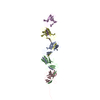+Search query
-Structure paper
| Title | Architecture of the biofilm-associated archaic Chaperone-Usher pilus CupE from Pseudomonas aeruginosa. |
|---|---|
| Journal, issue, pages | PLoS Pathog, Vol. 19, Issue 4, Page e1011177, Year 2023 |
| Publish date | Apr 14, 2023 |
 Authors Authors | Jan Böhning / Adrian W Dobbelstein / Nina Sulkowski / Kira Eilers / Andriko von Kügelgen / Abul K Tarafder / Sew-Yeu Peak-Chew / Mark Skehel / Vikram Alva / Alain Filloux / Tanmay A M Bharat /   |
| PubMed Abstract | Chaperone-Usher Pathway (CUP) pili are major adhesins in Gram-negative bacteria, mediating bacterial adherence to biotic and abiotic surfaces. While classical CUP pili have been extensively ...Chaperone-Usher Pathway (CUP) pili are major adhesins in Gram-negative bacteria, mediating bacterial adherence to biotic and abiotic surfaces. While classical CUP pili have been extensively characterized, little is known about so-called archaic CUP pili, which are phylogenetically widespread and promote biofilm formation by several human pathogens. In this study, we present the electron cryomicroscopy structure of the archaic CupE pilus from the opportunistic human pathogen Pseudomonas aeruginosa. We show that CupE1 subunits within the pilus are arranged in a zigzag architecture, containing an N-terminal donor β-strand extending from each subunit into the next, where it is anchored by hydrophobic interactions, with comparatively weaker interactions at the rest of the inter-subunit interface. Imaging CupE pili on the surface of P. aeruginosa cells using electron cryotomography shows that CupE pili adopt variable curvatures in response to their environment, which might facilitate their role in promoting cellular attachment. Finally, bioinformatic analysis shows the widespread abundance of cupE genes in isolates of P. aeruginosa and the co-occurrence of cupE with other cup clusters, suggesting interdependence of cup pili in regulating bacterial adherence within biofilms. Taken together, our study provides insights into the architecture of archaic CUP pili, providing a structural basis for understanding their role in promoting cellular adhesion and biofilm formation in P. aeruginosa. |
 External links External links |  PLoS Pathog / PLoS Pathog /  PubMed:37058467 / PubMed:37058467 /  PubMed Central PubMed Central |
| Methods | EM (helical sym.) |
| Resolution | 3.5 - 4.1 Å |
| Structure data | EMDB-16683, PDB-8cio:  EMDB-16686: CupE pilus (CupE1 111-113 AGA mutant) |
| Source |
|
 Keywords Keywords | PROTEIN FIBRIL / Pseudomonas aeruginosa / pilus / Chaperone-Usher / Chaperone-Usher Pathway / adhesin / biofilm |
 Movie
Movie Controller
Controller Structure viewers
Structure viewers About Yorodumi Papers
About Yorodumi Papers






